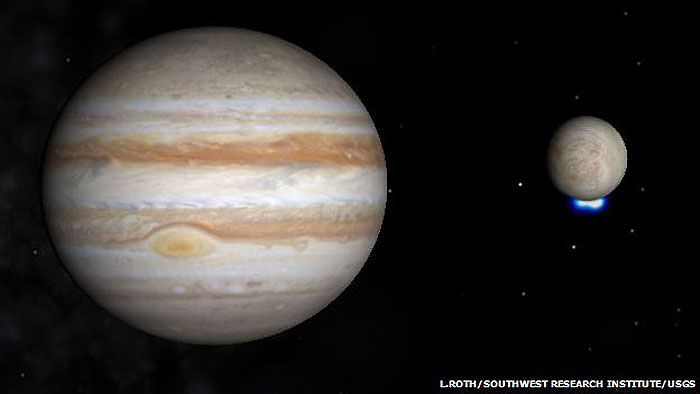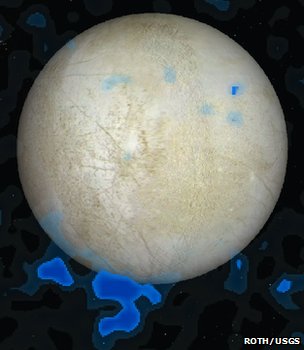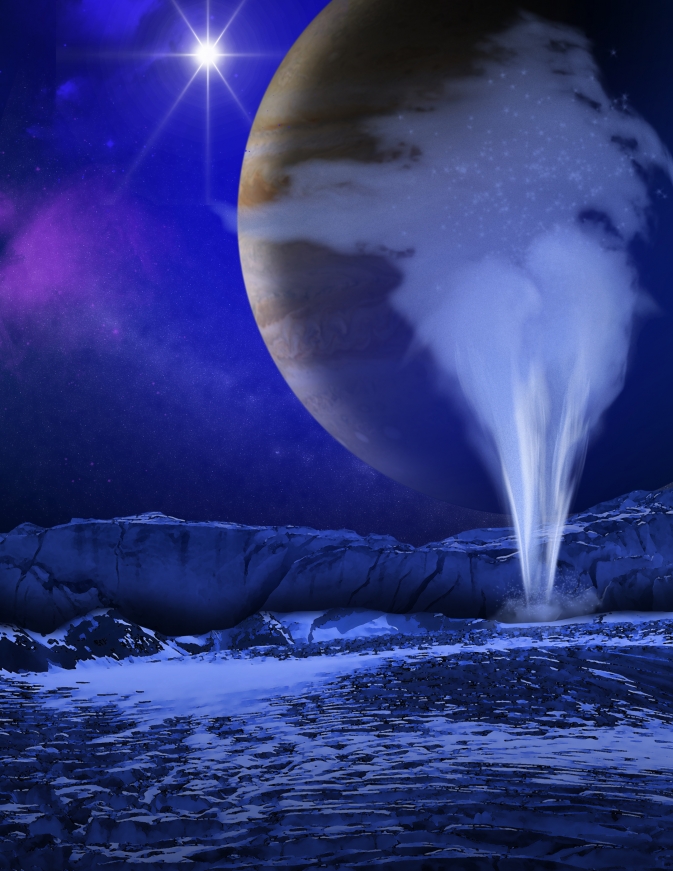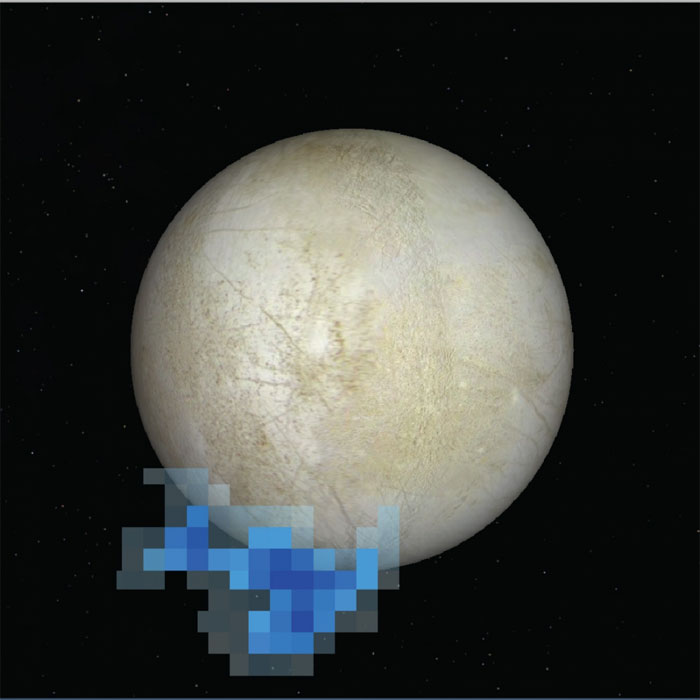.

Water spouts taller than Mt Everest appear to burst out of Europa when it is farthest from Jupiter
.
Water may be spouting from Jupiter's icy moon Europa - considered one of the best places to find alien life in the Solar System.
Images by the Hubble Space Telescope show surpluses of hydrogen and oxygen in the moon's southern hemisphere, say astronomers writing in Science journal.
If confirmed as water vapour plumes, it raises hopes that Europa's underground ocean can be accessed from its surface.
Future missions could probe these seas for signs of life.
Nasa's planetary science chief Dr James Green told BBC News: "The presence of the water has led scientists to speculate that the Europa we know today harbours life.
"The plumes are incredibly exciting if they are there - they are bringing up material from the ocean. Perhaps there are organic molecules lying there on the surface of Europa."
The findings were reported at the American Geophysical Union (AGU) Fall Meeting in San Francisco, California.
Scientists discovered the enormous fountains in images taken by Hubble in November and December of last year, as well as older images from 1999.
.

Signatures of water (blue) detected by Hubble are overlayed on an image of Europa
.
They saw evidence of water being broken apart into hydrogen and oxygen over the south polar regions of Europa.
"They are consistent with two 200-km-high (125 mile-high) plumes of water vapour," said lead author Lorenz Roth, of Southwest Research Institute in San Antonio, Texas.
Every second, seven tonnes of material is ejected from the moon's surface.
Dr Kurt Retherford, also of the Southwest Research Institute, told the AGU meeting: "This is just an amazing amount.
"It is travelling at 700m a second... All of this gas comes out, and almost all falls back towards the surface - it doesn't escape out into space."
These plumes appear to be transient - they arise for just seven hours at a time.
They peak when Europa is at its farthest from Jupiter (the apocentre of its orbit) and vanish when it comes closest (the pericentre).
This means that tidal acceleration could be driving water spouting - by opening cracks in the surface ice, the researchers propose.
The team is not yet sure whether these fissures go all the way down to the liquid water beneath the moon's icy crust, or whether some other mechanism is bringing the vapour to the surface.
The researchers also want to investigate whether the plumes are similar to those seen on Saturn's moon Enceladus, where high-pressure vapour emissions escape from very narrow cracks on the body's surface.
"We have a lot of questions about how this works," said Dr Retherford.
"How thick is the ice crust? Are there lakes and ponds embedded within the layers of the ice? Do these cracks go down really deep, do they really touch the liquid water down below?
"We don't know all of these things."
The team said exploration for Europa should now be made a priority.
The US Space Agency has made some preliminary plans for a mission to the moon - the Europa Clipper, which could fly past the plumes.
However, budgetary constraints mean it may not happen for some time.
Dr Green said: "The Europa Clipper is a very expensive venture. It is expensive because it is designed to last for a fairly long period of time, potentially a year or a number of years in a very harsh radioactive environment.
"So consequently that is what we would call a flagship.
"And right now, the budget horizon is such that we are deferring that kind of mission later into the decade."
Quelle: BBC
.
Hubble Space Telescope Sees Evidence of Water Vapor Venting off Jovian Moon

This is an artist's concept of a plume of water vapor thought to be ejected off the frigid, icy surface of the Jovian moon Europa, located about 500 million miles (800 million kilometers) from the sun.
Image Credit: NASA/ESA/K. Retherford/SWRI
.
NASA's Hubble Space Telescope has observed water vapor above the frigid south polar region of Jupiter's moon Europa, providing the first strong evidence of water plumes erupting off the moon's surface.
Previous scientific findings from other sources already point to the existence of an ocean located under Europa's icy crust. Researchers are not yet certain whether the detected water vapor is generated by water plumes erupting on the surface, but they are confident this is the most likely explanation.
Should further observations support the finding, it would make Europa the second moon in the solar system known to have water vapor plumes. The findings were published in the Thursday, Dec. 12, online issue of Science Express, and reported at the meeting of the American Geophysical Union in San Francisco.
"By far the simplest explanation for this water vapor is that it erupted from plumes on the surface of Europa," said lead author Lorenz Roth of Southwest Research Institute in San Antonio. "If those plumes are connected with the subsurface water ocean we are confident exists under Europa's crust, then this means that future investigations can directly investigate the chemical makeup of Europa's potentially habitable environment without drilling through layers of ice. And that is tremendously exciting,"
In 2005, NASA's Cassini orbiter detected jets of water vapor and dust spewing off the surface of Saturn's moon Enceladus. Although ice and dust particles subsequently have been found in the Enceladus plumes, only water vapor gases have been measured at Europa so far.
Hubble spectroscopic observations provided the evidence for Europa plumes in December 2012. Time sampling of Europa’s aurora emissions measured by Hubble's imaging spectrograph enabled the researchers to distinguish between features created by charged particles from Jupiter's magnetic bubble and plumes from Europa’s surface, and to also rule out more exotic explanations such as serendipitously observing a rare meteorite impact.
The imaging spectrograph detected faint ultraviolet light from an aurora, powered by Jupiter's intense magnetic field, near the moon's south pole. Excited atomic oxygen and hydrogen produce a variable aurora glow and leave a telltale sign that they are products of water molecules being broken apart by electrons along magnetic field lines.
"We pushed Hubble to its limits to see this very faint emission. These could be stealth plumes, because they might be tenuous and difficult to observe in the visible light." said Joachim Saur of the University of Cologne in Germany. Saur, who is principal investigator of the Hubble observation campaign, co-wrote the paper with Roth.
Roth suggested long cracks on Europa's surface, known as lineae, might be venting water vapor into space. Cassini has seen similar fissures that host Enceladus' jets.
Also like Enceladus, the Hubble team found the intensity of the plumes varies with Europa's orbital position. Active jets have been seen only when Europa is farthest from Jupiter. But the researchers could not detect any sign of venting when Europa is closer to Jupiter.
One explanation for the variability is these lineae experience more stress as gravitational tidal forces push and pull on the moon and open vents at larger distances from Jupiter. The vents are narrowed or closed when the moon is closest to the gas giant planet.
"The apparent plume variability supports a key prediction that Europa should tidally flex by a significant amount if it has a subsurface ocean," said Kurt Retherford, also of Southwest Research Institute.
Europa's and Enceladus' plumes have remarkably similar abundances of water vapor. Because Europa has roughly 12 times more gravitational pull than Enceladus, the vapor, whose temperature is measured at minus 40 degrees Celsius, does not escape into space as it does at Enceladus. Instead, it falls back onto the surface after reaching an altitude of 125 miles, according to the Hubble measurements. This could leave bright surface features near the moon's south polar region, the researchers hypothesize.
"If confirmed, this new observation once again shows the power of the Hubble Space Telescope to explore and opens a new chapter in our search for potentially habitable environments in our solar system" said John Grunsfeld, an astronaut who participated in Hubble servicing missions and now serves as NASA's associate administrator for science in Washington. "The effort and risk we took to upgrade and repair Hubble becomes all the more worthwhile when we learn about exciting discoveries like this one from Europa."
The Hubble Space Telescope is a project of international cooperation between NASA and the European Space Agency. NASA's Goddard Space Flight Center in Greenbelt, Md., manages the telescope. The Space Telescope Science Institute (STScI) conducts Hubble science operations. The Association of Universities for Research in Astronomy Inc. in Washington operates STScI for NASA.
.

Water Vapor Over Europa
This graphic shows the location of water vapor detected over Europa's south pole in observations taken by NASA's Hubble Space Telescope in December 2012. This is the first strong evidence of water plumes erupting off Europa's surface.
Hubble didn't photograph plumes, but spectroscopically detected auroral emissions from oxygen and hydrogen. The aurora is powered by Jupiter's magnetic field. This is only the second moon in the solar system found ejecting water vapor from the frigid surface. The image of Europa is derived from a global surface map generated from combined observations taken by NASA's Voyager and Galileo space probes.
Image credit: NASA/ESA/L. Roth/SWRI/University of Cologne
.
Quelle: NASA
5505 Views
